Business Environment Analysis: Sainsbury's Report - BUS101
VerifiedAdded on 2023/01/07
|14
|3807
|20
Report
AI Summary
This report offers a comprehensive analysis of the business environment, focusing on the internal and external factors that influence organizations. It begins by defining the business environment and its impact, followed by a discussion of various organizational types, including public, private, and voluntary sectors, along with their legal structures. The report then examines the size and scope of different organizations, using Sainsbury's as a case study, and analyzes the relationship between organizational functions, such as finance, marketing, and human resources, and how they contribute to achieving objectives and structure. A comparison of micro, small, medium, and large enterprises is provided, highlighting the differences in their characteristics and operations. The report concludes with an analysis of Sainsbury's internal and external environment, identifying its strengths, weaknesses, and the influence of macro factors, offering insights into the interplay between these elements and the overall business performance.
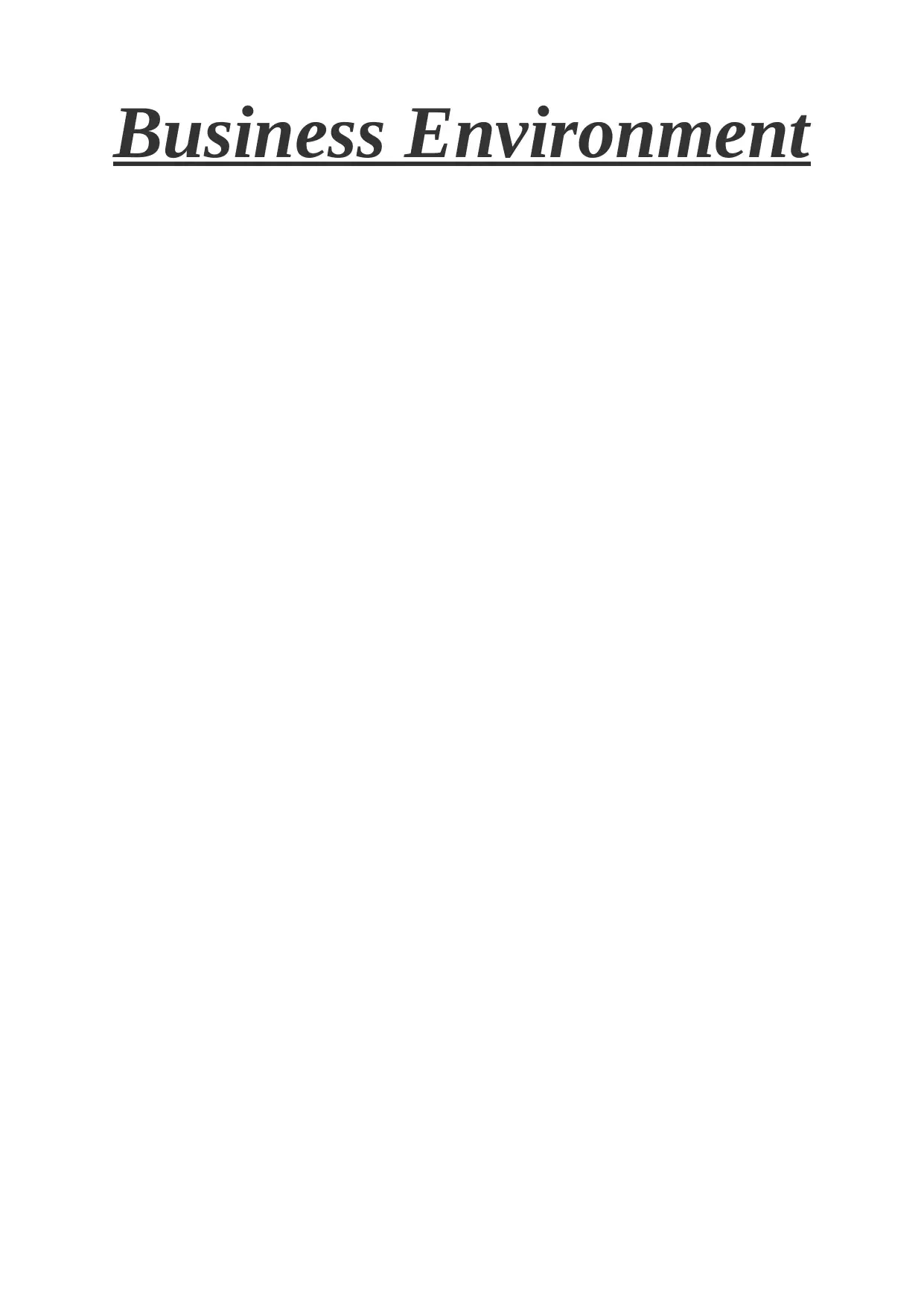
Business Environment
Paraphrase This Document
Need a fresh take? Get an instant paraphrase of this document with our AI Paraphraser
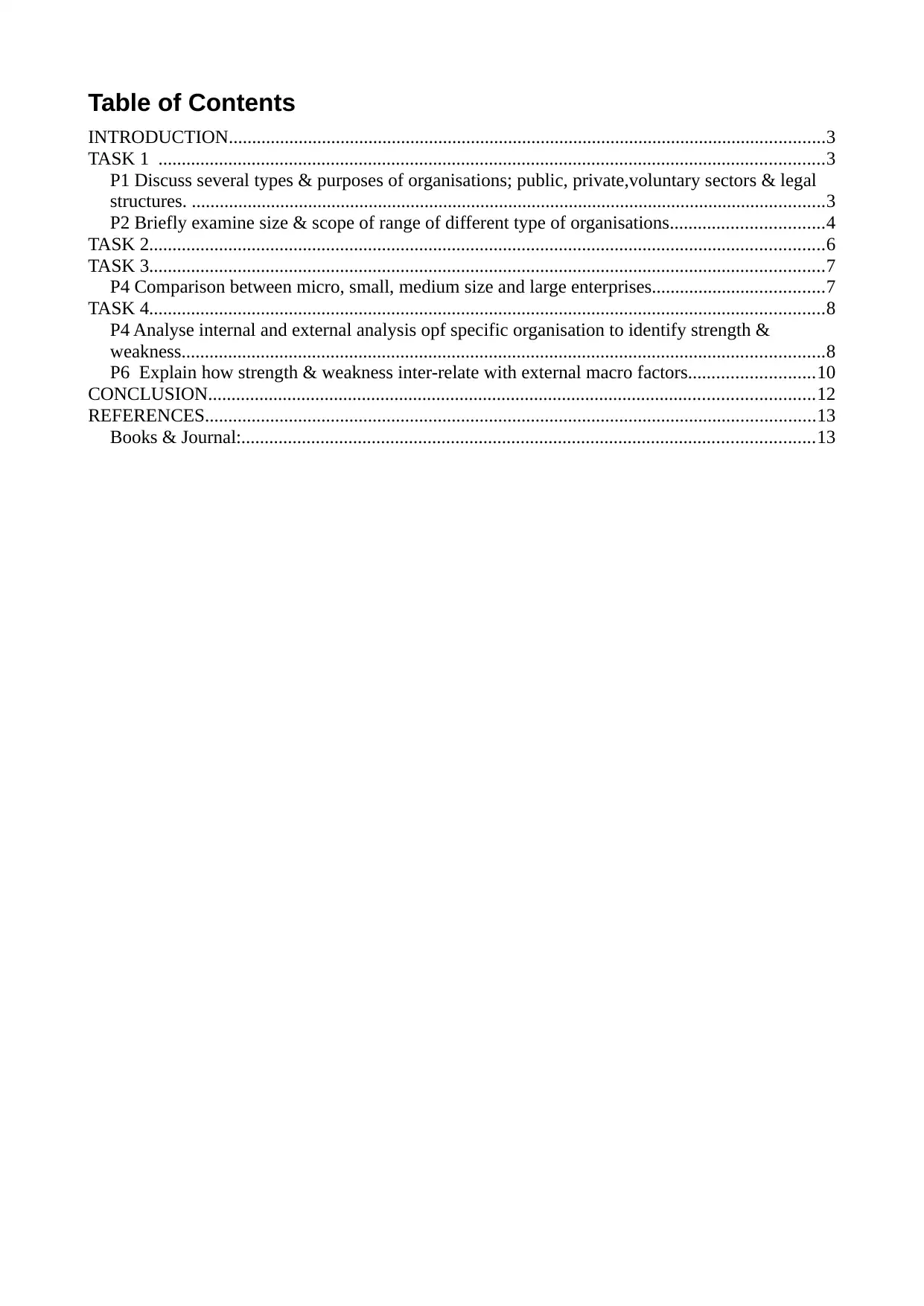
Table of Contents
INTRODUCTION................................................................................................................................3
TASK 1 ...............................................................................................................................................3
P1 Discuss several types & purposes of organisations; public, private,voluntary sectors & legal
structures. ........................................................................................................................................3
P2 Briefly examine size & scope of range of different type of organisations.................................4
TASK 2.................................................................................................................................................6
TASK 3.................................................................................................................................................7
P4 Comparison between micro, small, medium size and large enterprises.....................................7
TASK 4.................................................................................................................................................8
P4 Analyse internal and external analysis opf specific organisation to identify strength &
weakness..........................................................................................................................................8
P6 Explain how strength & weakness inter-relate with external macro factors...........................10
CONCLUSION..................................................................................................................................12
REFERENCES...................................................................................................................................13
Books & Journal:...........................................................................................................................13
INTRODUCTION................................................................................................................................3
TASK 1 ...............................................................................................................................................3
P1 Discuss several types & purposes of organisations; public, private,voluntary sectors & legal
structures. ........................................................................................................................................3
P2 Briefly examine size & scope of range of different type of organisations.................................4
TASK 2.................................................................................................................................................6
TASK 3.................................................................................................................................................7
P4 Comparison between micro, small, medium size and large enterprises.....................................7
TASK 4.................................................................................................................................................8
P4 Analyse internal and external analysis opf specific organisation to identify strength &
weakness..........................................................................................................................................8
P6 Explain how strength & weakness inter-relate with external macro factors...........................10
CONCLUSION..................................................................................................................................12
REFERENCES...................................................................................................................................13
Books & Journal:...........................................................................................................................13
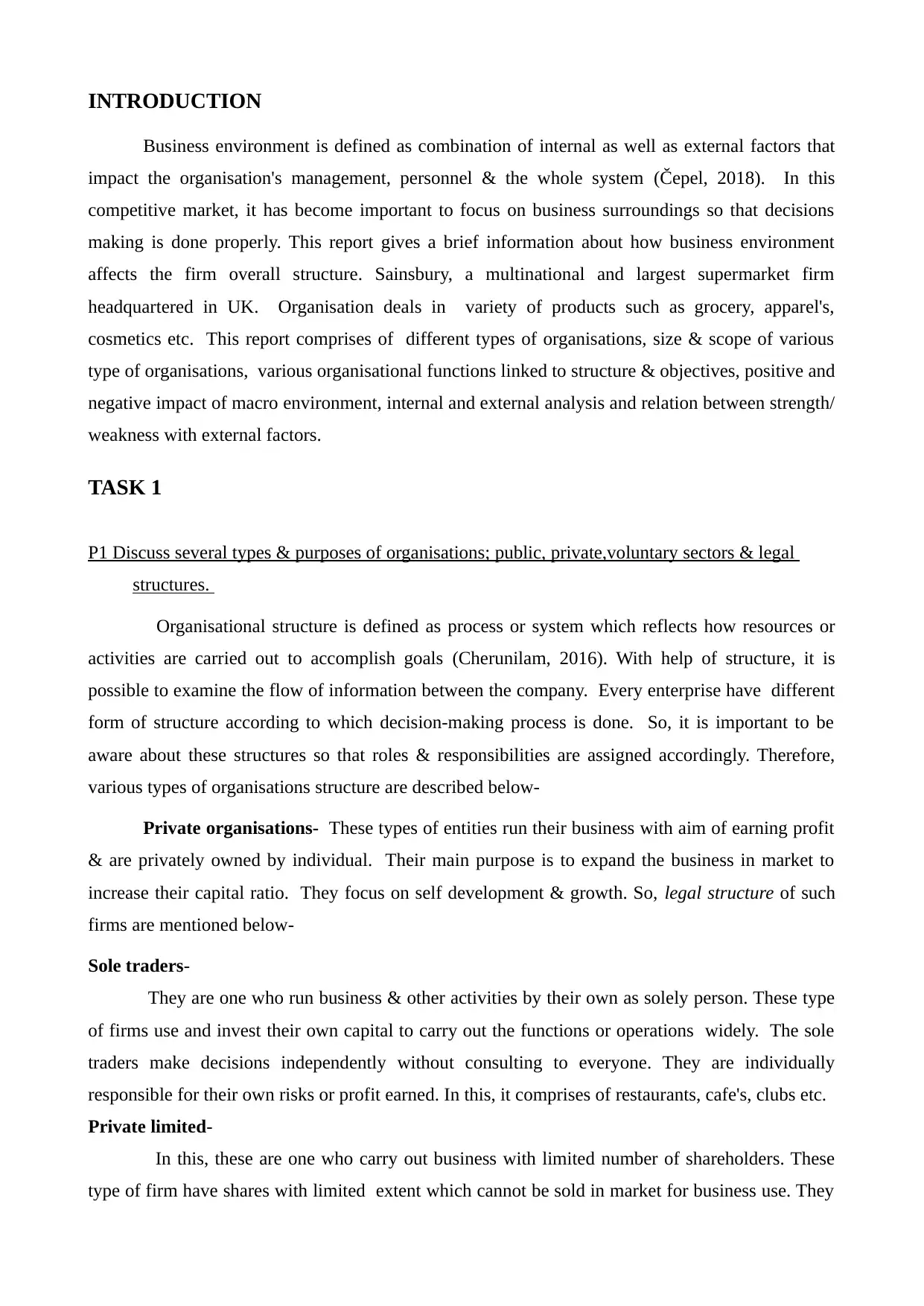
INTRODUCTION
Business environment is defined as combination of internal as well as external factors that
impact the organisation's management, personnel & the whole system (Čepel, 2018). In this
competitive market, it has become important to focus on business surroundings so that decisions
making is done properly. This report gives a brief information about how business environment
affects the firm overall structure. Sainsbury, a multinational and largest supermarket firm
headquartered in UK. Organisation deals in variety of products such as grocery, apparel's,
cosmetics etc. This report comprises of different types of organisations, size & scope of various
type of organisations, various organisational functions linked to structure & objectives, positive and
negative impact of macro environment, internal and external analysis and relation between strength/
weakness with external factors.
TASK 1
P1 Discuss several types & purposes of organisations; public, private,voluntary sectors & legal
structures.
Organisational structure is defined as process or system which reflects how resources or
activities are carried out to accomplish goals (Cherunilam, 2016). With help of structure, it is
possible to examine the flow of information between the company. Every enterprise have different
form of structure according to which decision-making process is done. So, it is important to be
aware about these structures so that roles & responsibilities are assigned accordingly. Therefore,
various types of organisations structure are described below-
Private organisations- These types of entities run their business with aim of earning profit
& are privately owned by individual. Their main purpose is to expand the business in market to
increase their capital ratio. They focus on self development & growth. So, legal structure of such
firms are mentioned below-
Sole traders-
They are one who run business & other activities by their own as solely person. These type
of firms use and invest their own capital to carry out the functions or operations widely. The sole
traders make decisions independently without consulting to everyone. They are individually
responsible for their own risks or profit earned. In this, it comprises of restaurants, cafe's, clubs etc.
Private limited-
In this, these are one who carry out business with limited number of shareholders. These
type of firm have shares with limited extent which cannot be sold in market for business use. They
Business environment is defined as combination of internal as well as external factors that
impact the organisation's management, personnel & the whole system (Čepel, 2018). In this
competitive market, it has become important to focus on business surroundings so that decisions
making is done properly. This report gives a brief information about how business environment
affects the firm overall structure. Sainsbury, a multinational and largest supermarket firm
headquartered in UK. Organisation deals in variety of products such as grocery, apparel's,
cosmetics etc. This report comprises of different types of organisations, size & scope of various
type of organisations, various organisational functions linked to structure & objectives, positive and
negative impact of macro environment, internal and external analysis and relation between strength/
weakness with external factors.
TASK 1
P1 Discuss several types & purposes of organisations; public, private,voluntary sectors & legal
structures.
Organisational structure is defined as process or system which reflects how resources or
activities are carried out to accomplish goals (Cherunilam, 2016). With help of structure, it is
possible to examine the flow of information between the company. Every enterprise have different
form of structure according to which decision-making process is done. So, it is important to be
aware about these structures so that roles & responsibilities are assigned accordingly. Therefore,
various types of organisations structure are described below-
Private organisations- These types of entities run their business with aim of earning profit
& are privately owned by individual. Their main purpose is to expand the business in market to
increase their capital ratio. They focus on self development & growth. So, legal structure of such
firms are mentioned below-
Sole traders-
They are one who run business & other activities by their own as solely person. These type
of firms use and invest their own capital to carry out the functions or operations widely. The sole
traders make decisions independently without consulting to everyone. They are individually
responsible for their own risks or profit earned. In this, it comprises of restaurants, cafe's, clubs etc.
Private limited-
In this, these are one who carry out business with limited number of shareholders. These
type of firm have shares with limited extent which cannot be sold in market for business use. They
⊘ This is a preview!⊘
Do you want full access?
Subscribe today to unlock all pages.

Trusted by 1+ million students worldwide

do not allow public to participate in decision making process. They only allow trade of shares in
between the friends or families who are involved in business activities. For example- JCB,
Walmart etc. comes under this category of enterprise.
Public limited companies-
These are one which operate with aim of providing services & products in market. In such
type of businesses, shares can be used for sale as well as purchase. Also, decision making is being
carried by participating every individual in firm. Moreover, freedom of expression is present & is
enjoyed by every person. For example- MC Donald is to be considered as public limited company.
Partnership-
It is also considered a private organisations because in this profit, risks etc. are shared by
partners equally. It is also used for business expansion at global level. For example- Louis Vuitton
& BMW have been into partnership with each other.
Public Organisation- These kind of enterprise are one which are being controlled,
managed & run by government permissions. Main motive of these are to provide public services to
citizen of society. Mostly these includes petrol, shelter, water etc. For example- HSBC Holdings
comes under this category as it is largest bank of UK & provide variety of services such as credit
card, debit card, loan etc.(Gaganis, 2019).
Central government department-
These type of entities run their activities by properly following rules, regulations, & certain
guidelines which are proposes by government.
Voluntary Organisation- They are those who carry out their functions, operations with aim
of social welfare & to help citizen of society. They generate capital for business from money
lenders, business man, banks etc. Legal structure is discussed below-
Trust- It is association which is made of shareholders, contractual bodies etc. These
involves groups of people who manages this association. (Taylor, 2019)
Therefore, the stated paragraph depicts that there are several kinds of organisations who run
their business according to their legal structure. It is seen that legal structure of every organisation is
different form each other. So, purpose of each entity is also different which means that with correct
analysis entrepreneur can selects their choice of firm. Moreover, by properly following structures it
is easier to adopt appropriate for of entity.
P2 Briefly examine size & scope of range of different type of organisations
It is crucial for every entity to focus on their size as well as scope so that they are aware
about their needed resources or capital. Every entity have heterogeneous mission, goals which they
accomplish within a period of time.
between the friends or families who are involved in business activities. For example- JCB,
Walmart etc. comes under this category of enterprise.
Public limited companies-
These are one which operate with aim of providing services & products in market. In such
type of businesses, shares can be used for sale as well as purchase. Also, decision making is being
carried by participating every individual in firm. Moreover, freedom of expression is present & is
enjoyed by every person. For example- MC Donald is to be considered as public limited company.
Partnership-
It is also considered a private organisations because in this profit, risks etc. are shared by
partners equally. It is also used for business expansion at global level. For example- Louis Vuitton
& BMW have been into partnership with each other.
Public Organisation- These kind of enterprise are one which are being controlled,
managed & run by government permissions. Main motive of these are to provide public services to
citizen of society. Mostly these includes petrol, shelter, water etc. For example- HSBC Holdings
comes under this category as it is largest bank of UK & provide variety of services such as credit
card, debit card, loan etc.(Gaganis, 2019).
Central government department-
These type of entities run their activities by properly following rules, regulations, & certain
guidelines which are proposes by government.
Voluntary Organisation- They are those who carry out their functions, operations with aim
of social welfare & to help citizen of society. They generate capital for business from money
lenders, business man, banks etc. Legal structure is discussed below-
Trust- It is association which is made of shareholders, contractual bodies etc. These
involves groups of people who manages this association. (Taylor, 2019)
Therefore, the stated paragraph depicts that there are several kinds of organisations who run
their business according to their legal structure. It is seen that legal structure of every organisation is
different form each other. So, purpose of each entity is also different which means that with correct
analysis entrepreneur can selects their choice of firm. Moreover, by properly following structures it
is easier to adopt appropriate for of entity.
P2 Briefly examine size & scope of range of different type of organisations
It is crucial for every entity to focus on their size as well as scope so that they are aware
about their needed resources or capital. Every entity have heterogeneous mission, goals which they
accomplish within a period of time.
Paraphrase This Document
Need a fresh take? Get an instant paraphrase of this document with our AI Paraphraser
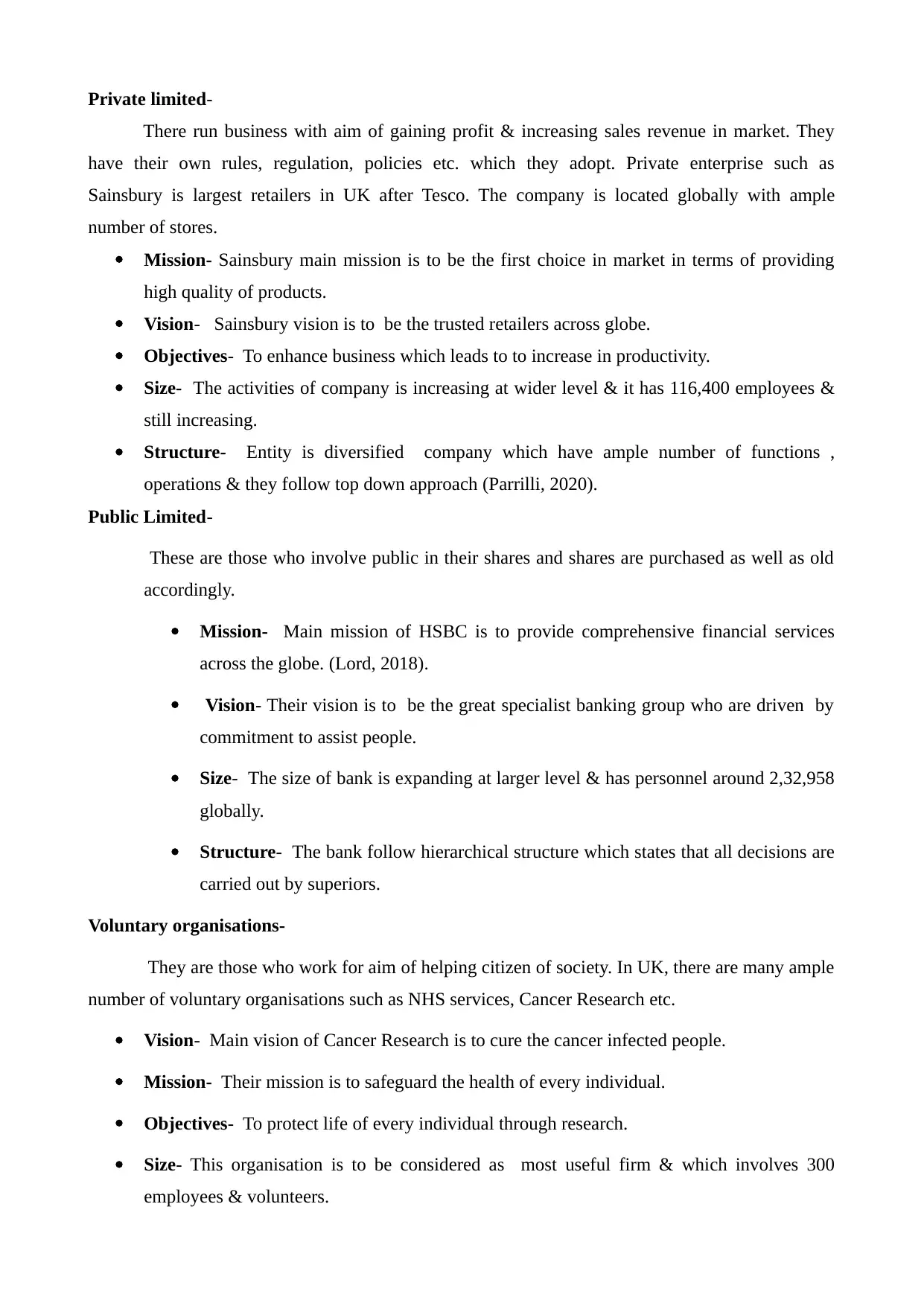
Private limited-
There run business with aim of gaining profit & increasing sales revenue in market. They
have their own rules, regulation, policies etc. which they adopt. Private enterprise such as
Sainsbury is largest retailers in UK after Tesco. The company is located globally with ample
number of stores.
Mission- Sainsbury main mission is to be the first choice in market in terms of providing
high quality of products.
Vision- Sainsbury vision is to be the trusted retailers across globe.
Objectives- To enhance business which leads to to increase in productivity.
Size- The activities of company is increasing at wider level & it has 116,400 employees &
still increasing.
Structure- Entity is diversified company which have ample number of functions ,
operations & they follow top down approach (Parrilli, 2020).
Public Limited-
These are those who involve public in their shares and shares are purchased as well as old
accordingly.
Mission- Main mission of HSBC is to provide comprehensive financial services
across the globe. (Lord, 2018).
Vision- Their vision is to be the great specialist banking group who are driven by
commitment to assist people.
Size- The size of bank is expanding at larger level & has personnel around 2,32,958
globally.
Structure- The bank follow hierarchical structure which states that all decisions are
carried out by superiors.
Voluntary organisations-
They are those who work for aim of helping citizen of society. In UK, there are many ample
number of voluntary organisations such as NHS services, Cancer Research etc.
Vision- Main vision of Cancer Research is to cure the cancer infected people.
Mission- Their mission is to safeguard the health of every individual.
Objectives- To protect life of every individual through research.
Size- This organisation is to be considered as most useful firm & which involves 300
employees & volunteers.
There run business with aim of gaining profit & increasing sales revenue in market. They
have their own rules, regulation, policies etc. which they adopt. Private enterprise such as
Sainsbury is largest retailers in UK after Tesco. The company is located globally with ample
number of stores.
Mission- Sainsbury main mission is to be the first choice in market in terms of providing
high quality of products.
Vision- Sainsbury vision is to be the trusted retailers across globe.
Objectives- To enhance business which leads to to increase in productivity.
Size- The activities of company is increasing at wider level & it has 116,400 employees &
still increasing.
Structure- Entity is diversified company which have ample number of functions ,
operations & they follow top down approach (Parrilli, 2020).
Public Limited-
These are those who involve public in their shares and shares are purchased as well as old
accordingly.
Mission- Main mission of HSBC is to provide comprehensive financial services
across the globe. (Lord, 2018).
Vision- Their vision is to be the great specialist banking group who are driven by
commitment to assist people.
Size- The size of bank is expanding at larger level & has personnel around 2,32,958
globally.
Structure- The bank follow hierarchical structure which states that all decisions are
carried out by superiors.
Voluntary organisations-
They are those who work for aim of helping citizen of society. In UK, there are many ample
number of voluntary organisations such as NHS services, Cancer Research etc.
Vision- Main vision of Cancer Research is to cure the cancer infected people.
Mission- Their mission is to safeguard the health of every individual.
Objectives- To protect life of every individual through research.
Size- This organisation is to be considered as most useful firm & which involves 300
employees & volunteers.
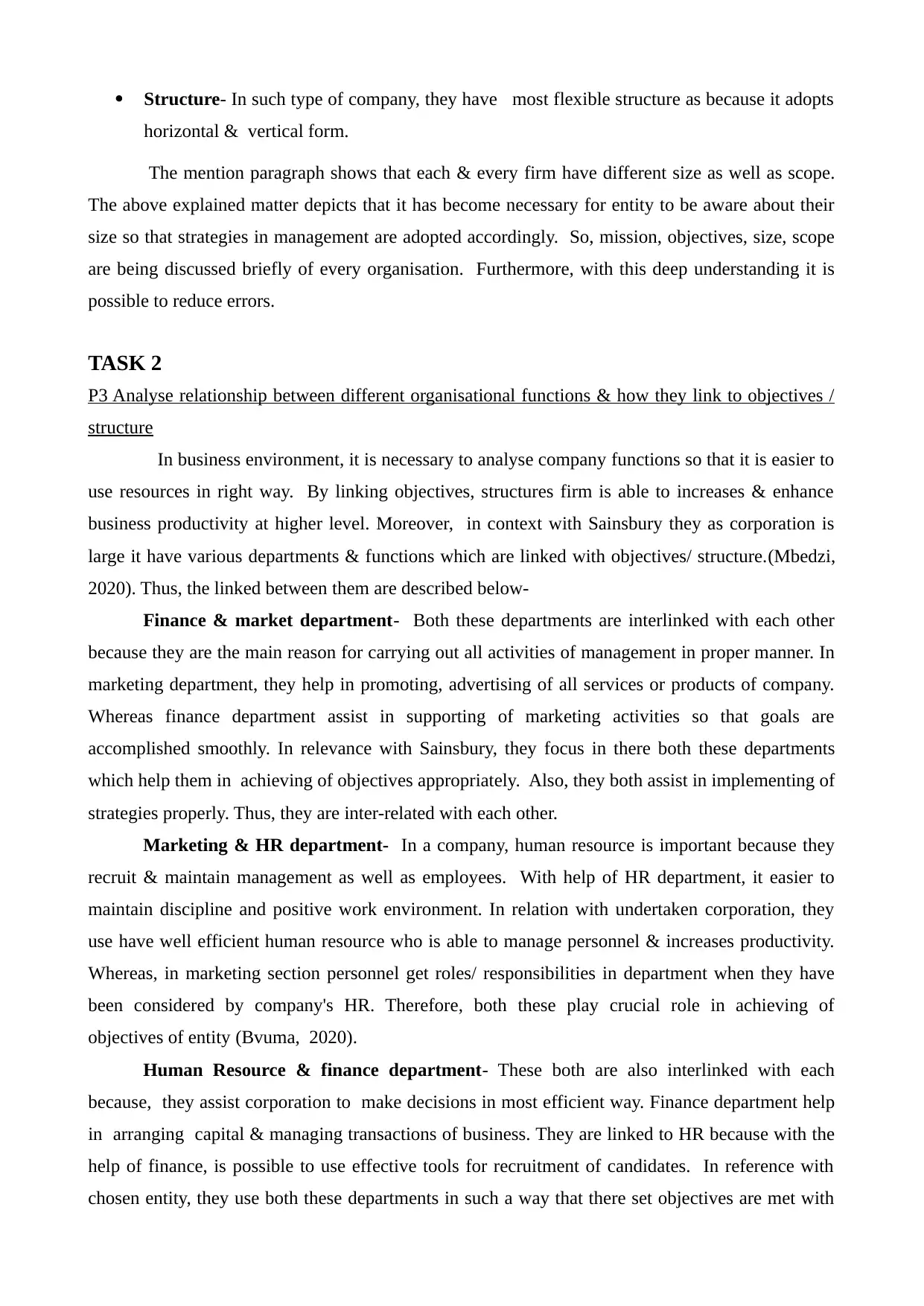
Structure- In such type of company, they have most flexible structure as because it adopts
horizontal & vertical form.
The mention paragraph shows that each & every firm have different size as well as scope.
The above explained matter depicts that it has become necessary for entity to be aware about their
size so that strategies in management are adopted accordingly. So, mission, objectives, size, scope
are being discussed briefly of every organisation. Furthermore, with this deep understanding it is
possible to reduce errors.
TASK 2
P3 Analyse relationship between different organisational functions & how they link to objectives /
structure
In business environment, it is necessary to analyse company functions so that it is easier to
use resources in right way. By linking objectives, structures firm is able to increases & enhance
business productivity at higher level. Moreover, in context with Sainsbury they as corporation is
large it have various departments & functions which are linked with objectives/ structure.(Mbedzi,
2020). Thus, the linked between them are described below-
Finance & market department- Both these departments are interlinked with each other
because they are the main reason for carrying out all activities of management in proper manner. In
marketing department, they help in promoting, advertising of all services or products of company.
Whereas finance department assist in supporting of marketing activities so that goals are
accomplished smoothly. In relevance with Sainsbury, they focus in there both these departments
which help them in achieving of objectives appropriately. Also, they both assist in implementing of
strategies properly. Thus, they are inter-related with each other.
Marketing & HR department- In a company, human resource is important because they
recruit & maintain management as well as employees. With help of HR department, it easier to
maintain discipline and positive work environment. In relation with undertaken corporation, they
use have well efficient human resource who is able to manage personnel & increases productivity.
Whereas, in marketing section personnel get roles/ responsibilities in department when they have
been considered by company's HR. Therefore, both these play crucial role in achieving of
objectives of entity (Bvuma, 2020).
Human Resource & finance department- These both are also interlinked with each
because, they assist corporation to make decisions in most efficient way. Finance department help
in arranging capital & managing transactions of business. They are linked to HR because with the
help of finance, is possible to use effective tools for recruitment of candidates. In reference with
chosen entity, they use both these departments in such a way that there set objectives are met with
horizontal & vertical form.
The mention paragraph shows that each & every firm have different size as well as scope.
The above explained matter depicts that it has become necessary for entity to be aware about their
size so that strategies in management are adopted accordingly. So, mission, objectives, size, scope
are being discussed briefly of every organisation. Furthermore, with this deep understanding it is
possible to reduce errors.
TASK 2
P3 Analyse relationship between different organisational functions & how they link to objectives /
structure
In business environment, it is necessary to analyse company functions so that it is easier to
use resources in right way. By linking objectives, structures firm is able to increases & enhance
business productivity at higher level. Moreover, in context with Sainsbury they as corporation is
large it have various departments & functions which are linked with objectives/ structure.(Mbedzi,
2020). Thus, the linked between them are described below-
Finance & market department- Both these departments are interlinked with each other
because they are the main reason for carrying out all activities of management in proper manner. In
marketing department, they help in promoting, advertising of all services or products of company.
Whereas finance department assist in supporting of marketing activities so that goals are
accomplished smoothly. In relevance with Sainsbury, they focus in there both these departments
which help them in achieving of objectives appropriately. Also, they both assist in implementing of
strategies properly. Thus, they are inter-related with each other.
Marketing & HR department- In a company, human resource is important because they
recruit & maintain management as well as employees. With help of HR department, it easier to
maintain discipline and positive work environment. In relation with undertaken corporation, they
use have well efficient human resource who is able to manage personnel & increases productivity.
Whereas, in marketing section personnel get roles/ responsibilities in department when they have
been considered by company's HR. Therefore, both these play crucial role in achieving of
objectives of entity (Bvuma, 2020).
Human Resource & finance department- These both are also interlinked with each
because, they assist corporation to make decisions in most efficient way. Finance department help
in arranging capital & managing transactions of business. They are linked to HR because with the
help of finance, is possible to use effective tools for recruitment of candidates. In reference with
chosen entity, they use both these departments in such a way that there set objectives are met with
⊘ This is a preview!⊘
Do you want full access?
Subscribe today to unlock all pages.

Trusted by 1+ million students worldwide

proper considerations. Without HR, it is not possible to manage business environment as they help
in formulating policies within the management.
So, after examining of above matter it is seen that it is essential for manager to understand
role of every department so that it will be easier for them to accomplish goals within a period of
time. Furthermore, functions & structure are inter -related with each other through which it is easier
to implement strategies. By understanding relationships between them, chances of elimination of
errors get reduced. Each department is inter connected to each other according to which employees
gets their roles/ responsibilities. Also, d
TASK 3
P4 Comparison between micro, small, medium size and large enterprises
Market is becoming wider & it has become important to understand the type of enterprises.
There are various types of enterprises which are small, medium, & large enterprises. In this
competitive era, it has become essential to choose appropriate type of enterprises so that it is
possible to achieve all goals & objectives when correct form of entity is being chosen by
entrepreneurs. IT is important to understand business environment so that problem do not occur in
future period of time. So, the comparison between these are mentioned below-
BASIS Micro
Enterprises
Small firm Medium
enterprises
Large enterprises
Meaning These are those in
which investment
is not more that 25
Lakhs & have
limited number of
members in
company.
A small enterprise
is one in which
investment is
between 25 lakhs
& which does not
exceed. (Kara,
2018).
These are those
who have the
investment
amount of about 5
crore but does not
go beyond 10
crore.
They are
enterprises in
which investment
has no limits &
who have at least
6000 employees in
entity. (David,
2018).
Funds In this, they raise
funds from banks
with small or
limited amounts.
They generate
capital for
business from
money lenders or
by own personal
savings.
They arrange
capital for
business by use
searching for
investors
In this, fund is
arranged through
selling of shares in
public or
management.
in formulating policies within the management.
So, after examining of above matter it is seen that it is essential for manager to understand
role of every department so that it will be easier for them to accomplish goals within a period of
time. Furthermore, functions & structure are inter -related with each other through which it is easier
to implement strategies. By understanding relationships between them, chances of elimination of
errors get reduced. Each department is inter connected to each other according to which employees
gets their roles/ responsibilities. Also, d
TASK 3
P4 Comparison between micro, small, medium size and large enterprises
Market is becoming wider & it has become important to understand the type of enterprises.
There are various types of enterprises which are small, medium, & large enterprises. In this
competitive era, it has become essential to choose appropriate type of enterprises so that it is
possible to achieve all goals & objectives when correct form of entity is being chosen by
entrepreneurs. IT is important to understand business environment so that problem do not occur in
future period of time. So, the comparison between these are mentioned below-
BASIS Micro
Enterprises
Small firm Medium
enterprises
Large enterprises
Meaning These are those in
which investment
is not more that 25
Lakhs & have
limited number of
members in
company.
A small enterprise
is one in which
investment is
between 25 lakhs
& which does not
exceed. (Kara,
2018).
These are those
who have the
investment
amount of about 5
crore but does not
go beyond 10
crore.
They are
enterprises in
which investment
has no limits &
who have at least
6000 employees in
entity. (David,
2018).
Funds In this, they raise
funds from banks
with small or
limited amounts.
They generate
capital for
business from
money lenders or
by own personal
savings.
They arrange
capital for
business by use
searching for
investors
In this, fund is
arranged through
selling of shares in
public or
management.
Paraphrase This Document
Need a fresh take? Get an instant paraphrase of this document with our AI Paraphraser
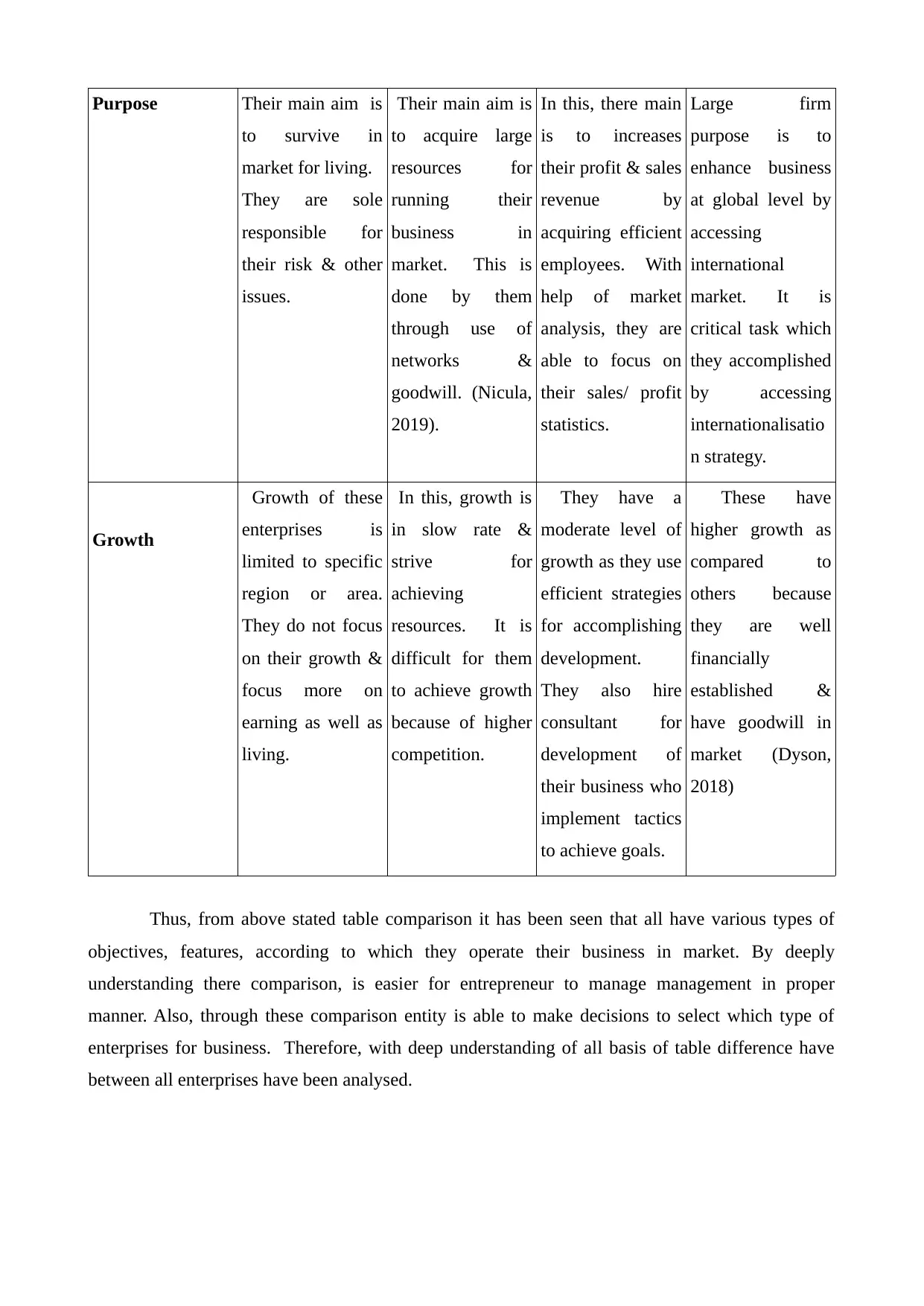
Purpose Their main aim is
to survive in
market for living.
They are sole
responsible for
their risk & other
issues.
Their main aim is
to acquire large
resources for
running their
business in
market. This is
done by them
through use of
networks &
goodwill. (Nicula,
2019).
In this, there main
is to increases
their profit & sales
revenue by
acquiring efficient
employees. With
help of market
analysis, they are
able to focus on
their sales/ profit
statistics.
Large firm
purpose is to
enhance business
at global level by
accessing
international
market. It is
critical task which
they accomplished
by accessing
internationalisatio
n strategy.
Growth
Growth of these
enterprises is
limited to specific
region or area.
They do not focus
on their growth &
focus more on
earning as well as
living.
In this, growth is
in slow rate &
strive for
achieving
resources. It is
difficult for them
to achieve growth
because of higher
competition.
They have a
moderate level of
growth as they use
efficient strategies
for accomplishing
development.
They also hire
consultant for
development of
their business who
implement tactics
to achieve goals.
These have
higher growth as
compared to
others because
they are well
financially
established &
have goodwill in
market (Dyson,
2018)
Thus, from above stated table comparison it has been seen that all have various types of
objectives, features, according to which they operate their business in market. By deeply
understanding there comparison, is easier for entrepreneur to manage management in proper
manner. Also, through these comparison entity is able to make decisions to select which type of
enterprises for business. Therefore, with deep understanding of all basis of table difference have
between all enterprises have been analysed.
to survive in
market for living.
They are sole
responsible for
their risk & other
issues.
Their main aim is
to acquire large
resources for
running their
business in
market. This is
done by them
through use of
networks &
goodwill. (Nicula,
2019).
In this, there main
is to increases
their profit & sales
revenue by
acquiring efficient
employees. With
help of market
analysis, they are
able to focus on
their sales/ profit
statistics.
Large firm
purpose is to
enhance business
at global level by
accessing
international
market. It is
critical task which
they accomplished
by accessing
internationalisatio
n strategy.
Growth
Growth of these
enterprises is
limited to specific
region or area.
They do not focus
on their growth &
focus more on
earning as well as
living.
In this, growth is
in slow rate &
strive for
achieving
resources. It is
difficult for them
to achieve growth
because of higher
competition.
They have a
moderate level of
growth as they use
efficient strategies
for accomplishing
development.
They also hire
consultant for
development of
their business who
implement tactics
to achieve goals.
These have
higher growth as
compared to
others because
they are well
financially
established &
have goodwill in
market (Dyson,
2018)
Thus, from above stated table comparison it has been seen that all have various types of
objectives, features, according to which they operate their business in market. By deeply
understanding there comparison, is easier for entrepreneur to manage management in proper
manner. Also, through these comparison entity is able to make decisions to select which type of
enterprises for business. Therefore, with deep understanding of all basis of table difference have
between all enterprises have been analysed.
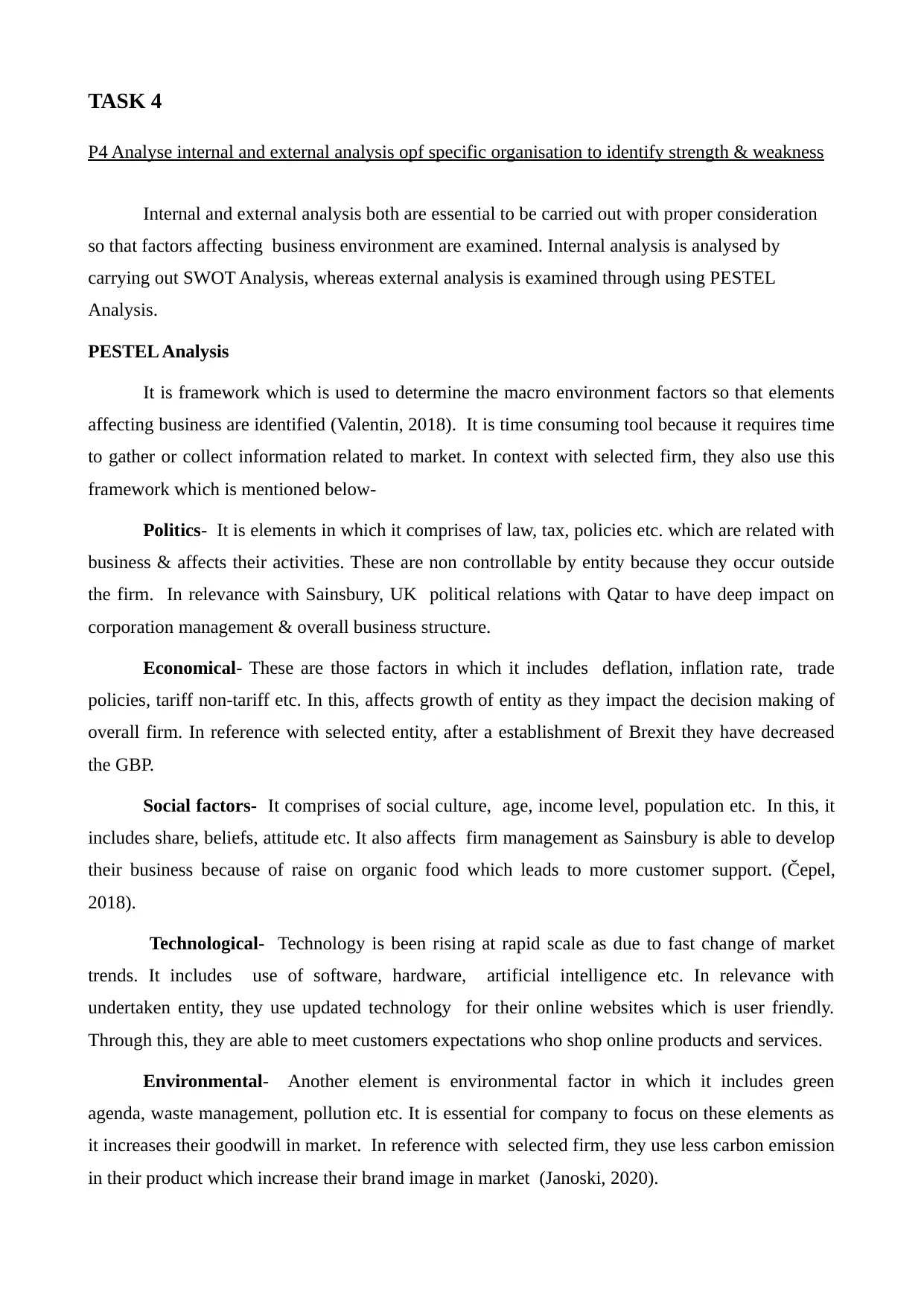
TASK 4
P4 Analyse internal and external analysis opf specific organisation to identify strength & weakness
Internal and external analysis both are essential to be carried out with proper consideration
so that factors affecting business environment are examined. Internal analysis is analysed by
carrying out SWOT Analysis, whereas external analysis is examined through using PESTEL
Analysis.
PESTEL Analysis
It is framework which is used to determine the macro environment factors so that elements
affecting business are identified (Valentin, 2018). It is time consuming tool because it requires time
to gather or collect information related to market. In context with selected firm, they also use this
framework which is mentioned below-
Politics- It is elements in which it comprises of law, tax, policies etc. which are related with
business & affects their activities. These are non controllable by entity because they occur outside
the firm. In relevance with Sainsbury, UK political relations with Qatar to have deep impact on
corporation management & overall business structure.
Economical- These are those factors in which it includes deflation, inflation rate, trade
policies, tariff non-tariff etc. In this, affects growth of entity as they impact the decision making of
overall firm. In reference with selected entity, after a establishment of Brexit they have decreased
the GBP.
Social factors- It comprises of social culture, age, income level, population etc. In this, it
includes share, beliefs, attitude etc. It also affects firm management as Sainsbury is able to develop
their business because of raise on organic food which leads to more customer support. (Čepel,
2018).
Technological- Technology is been rising at rapid scale as due to fast change of market
trends. It includes use of software, hardware, artificial intelligence etc. In relevance with
undertaken entity, they use updated technology for their online websites which is user friendly.
Through this, they are able to meet customers expectations who shop online products and services.
Environmental- Another element is environmental factor in which it includes green
agenda, waste management, pollution etc. It is essential for company to focus on these elements as
it increases their goodwill in market. In reference with selected firm, they use less carbon emission
in their product which increase their brand image in market (Janoski, 2020).
P4 Analyse internal and external analysis opf specific organisation to identify strength & weakness
Internal and external analysis both are essential to be carried out with proper consideration
so that factors affecting business environment are examined. Internal analysis is analysed by
carrying out SWOT Analysis, whereas external analysis is examined through using PESTEL
Analysis.
PESTEL Analysis
It is framework which is used to determine the macro environment factors so that elements
affecting business are identified (Valentin, 2018). It is time consuming tool because it requires time
to gather or collect information related to market. In context with selected firm, they also use this
framework which is mentioned below-
Politics- It is elements in which it comprises of law, tax, policies etc. which are related with
business & affects their activities. These are non controllable by entity because they occur outside
the firm. In relevance with Sainsbury, UK political relations with Qatar to have deep impact on
corporation management & overall business structure.
Economical- These are those factors in which it includes deflation, inflation rate, trade
policies, tariff non-tariff etc. In this, affects growth of entity as they impact the decision making of
overall firm. In reference with selected entity, after a establishment of Brexit they have decreased
the GBP.
Social factors- It comprises of social culture, age, income level, population etc. In this, it
includes share, beliefs, attitude etc. It also affects firm management as Sainsbury is able to develop
their business because of raise on organic food which leads to more customer support. (Čepel,
2018).
Technological- Technology is been rising at rapid scale as due to fast change of market
trends. It includes use of software, hardware, artificial intelligence etc. In relevance with
undertaken entity, they use updated technology for their online websites which is user friendly.
Through this, they are able to meet customers expectations who shop online products and services.
Environmental- Another element is environmental factor in which it includes green
agenda, waste management, pollution etc. It is essential for company to focus on these elements as
it increases their goodwill in market. In reference with selected firm, they use less carbon emission
in their product which increase their brand image in market (Janoski, 2020).
⊘ This is a preview!⊘
Do you want full access?
Subscribe today to unlock all pages.

Trusted by 1+ million students worldwide
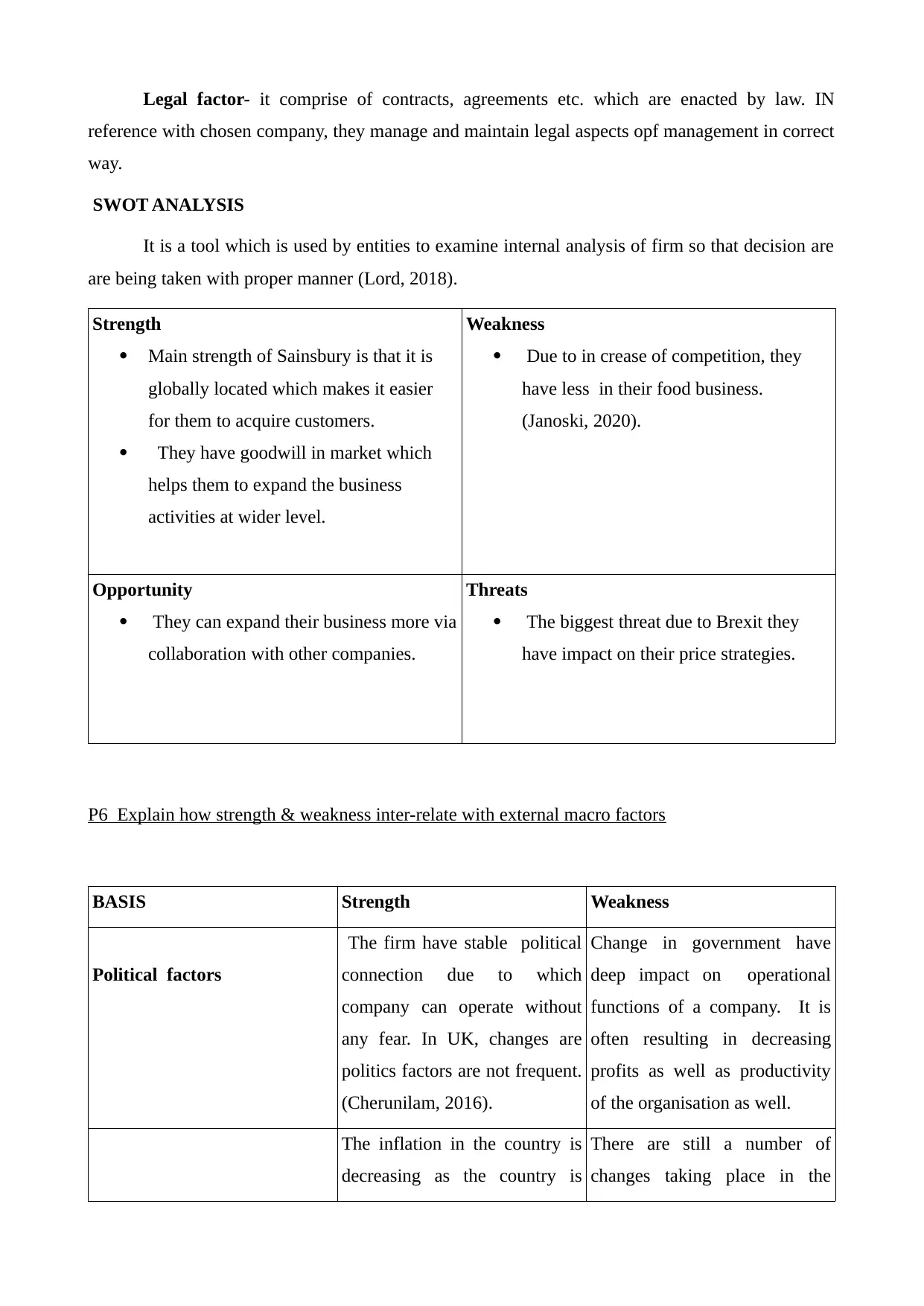
Legal factor- it comprise of contracts, agreements etc. which are enacted by law. IN
reference with chosen company, they manage and maintain legal aspects opf management in correct
way.
SWOT ANALYSIS
It is a tool which is used by entities to examine internal analysis of firm so that decision are
are being taken with proper manner (Lord, 2018).
Strength
Main strength of Sainsbury is that it is
globally located which makes it easier
for them to acquire customers.
They have goodwill in market which
helps them to expand the business
activities at wider level.
Weakness
Due to in crease of competition, they
have less in their food business.
(Janoski, 2020).
Opportunity
They can expand their business more via
collaboration with other companies.
Threats
The biggest threat due to Brexit they
have impact on their price strategies.
P6 Explain how strength & weakness inter-relate with external macro factors
BASIS Strength Weakness
Political factors
The firm have stable political
connection due to which
company can operate without
any fear. In UK, changes are
politics factors are not frequent.
(Cherunilam, 2016).
Change in government have
deep impact on operational
functions of a company. It is
often resulting in decreasing
profits as well as productivity
of the organisation as well.
The inflation in the country is
decreasing as the country is
There are still a number of
changes taking place in the
reference with chosen company, they manage and maintain legal aspects opf management in correct
way.
SWOT ANALYSIS
It is a tool which is used by entities to examine internal analysis of firm so that decision are
are being taken with proper manner (Lord, 2018).
Strength
Main strength of Sainsbury is that it is
globally located which makes it easier
for them to acquire customers.
They have goodwill in market which
helps them to expand the business
activities at wider level.
Weakness
Due to in crease of competition, they
have less in their food business.
(Janoski, 2020).
Opportunity
They can expand their business more via
collaboration with other companies.
Threats
The biggest threat due to Brexit they
have impact on their price strategies.
P6 Explain how strength & weakness inter-relate with external macro factors
BASIS Strength Weakness
Political factors
The firm have stable political
connection due to which
company can operate without
any fear. In UK, changes are
politics factors are not frequent.
(Cherunilam, 2016).
Change in government have
deep impact on operational
functions of a company. It is
often resulting in decreasing
profits as well as productivity
of the organisation as well.
The inflation in the country is
decreasing as the country is
There are still a number of
changes taking place in the
Paraphrase This Document
Need a fresh take? Get an instant paraphrase of this document with our AI Paraphraser

Economical moving towards development.
It is a great new for company as
the interest rates are also
constant and do not fluctuate
much.
economic environment which is
to be taken into consideration.
Social
It is necessary that company is
working on maintaining
relationship with society and
also fulfil there hanging needs.
The changes in taste and
preference may have negative
impact in sales and profit of
company.
Technological
It believes in taking first
m0over advantage in
technology.(Gaganis, 2019).
The high costs of technologies
requires huge investments.
Environment Company can take benefit from
increase in goodwill if they are
doing good for nature via low
wastage and renewable
resources of energy.
The industrial objectives of
company might have negative
impact on environment.
Legal Company follows all the rules
and laws which help them in
increasing brand image and
carry on all their functions
smoothly.
Not following it may lead
company to have negative
lawsuits against it. (Taylor,
2019).
It is a great new for company as
the interest rates are also
constant and do not fluctuate
much.
economic environment which is
to be taken into consideration.
Social
It is necessary that company is
working on maintaining
relationship with society and
also fulfil there hanging needs.
The changes in taste and
preference may have negative
impact in sales and profit of
company.
Technological
It believes in taking first
m0over advantage in
technology.(Gaganis, 2019).
The high costs of technologies
requires huge investments.
Environment Company can take benefit from
increase in goodwill if they are
doing good for nature via low
wastage and renewable
resources of energy.
The industrial objectives of
company might have negative
impact on environment.
Legal Company follows all the rules
and laws which help them in
increasing brand image and
carry on all their functions
smoothly.
Not following it may lead
company to have negative
lawsuits against it. (Taylor,
2019).
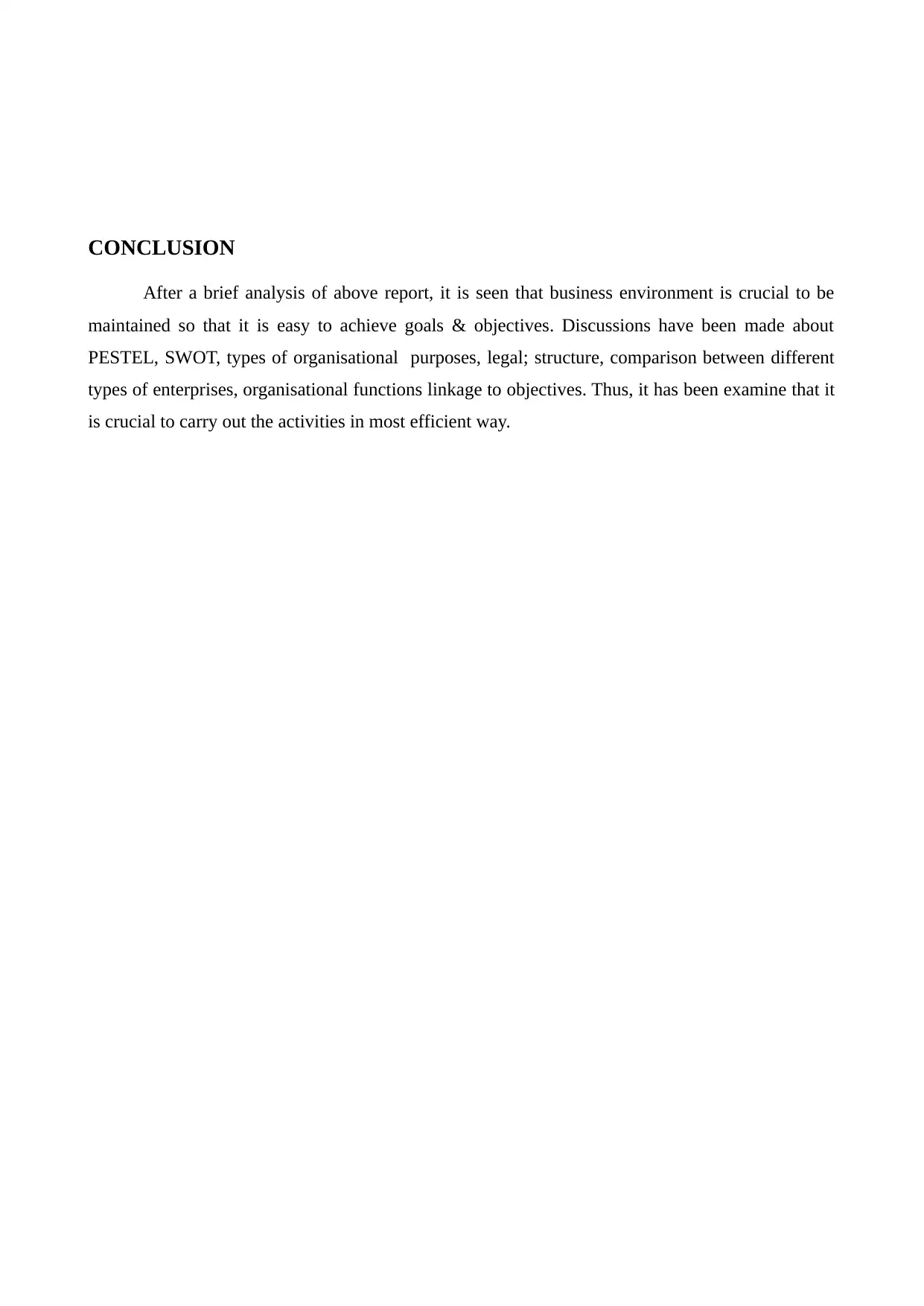
CONCLUSION
After a brief analysis of above report, it is seen that business environment is crucial to be
maintained so that it is easy to achieve goals & objectives. Discussions have been made about
PESTEL, SWOT, types of organisational purposes, legal; structure, comparison between different
types of enterprises, organisational functions linkage to objectives. Thus, it has been examine that it
is crucial to carry out the activities in most efficient way.
After a brief analysis of above report, it is seen that business environment is crucial to be
maintained so that it is easy to achieve goals & objectives. Discussions have been made about
PESTEL, SWOT, types of organisational purposes, legal; structure, comparison between different
types of enterprises, organisational functions linkage to objectives. Thus, it has been examine that it
is crucial to carry out the activities in most efficient way.
⊘ This is a preview!⊘
Do you want full access?
Subscribe today to unlock all pages.

Trusted by 1+ million students worldwide
1 out of 14
Related Documents
Your All-in-One AI-Powered Toolkit for Academic Success.
+13062052269
info@desklib.com
Available 24*7 on WhatsApp / Email
![[object Object]](/_next/static/media/star-bottom.7253800d.svg)
Unlock your academic potential
Copyright © 2020–2025 A2Z Services. All Rights Reserved. Developed and managed by ZUCOL.





